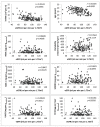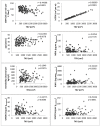Urinary biomarkers at early ADPKD disease stage
- PMID: 25875363
- PMCID: PMC4395321
- DOI: 10.1371/journal.pone.0123555
Urinary biomarkers at early ADPKD disease stage
Abstract
Background: Autosomal dominant polycystic kidney disease (ADPKD) is characterized by a decline in renal function at late disease stage when the majority of functional renal parenchyma is replaced by cystic tissue. Thus, kidney function, assessed by estimated glomerular filtration rate (eGFR) does not well represent disease burden in early disease. Here, we investigated various urinary markers for tubular injury and their association with disease burden in ADPKD patients at early disease course.
Methods: ADPKD patients between 18 and 40 years with an eGFR greater or equal to 70 ml per min per 1.73m2 were eligible for this cross-sectional study. Urinary Neutrophil Gelatinase-Associated Lipocalin (NGAL), Kidney Injury Molecule-1 (KIM-1), and Uromodulin (UMOD) were investigated by Enzyme-Linked Immunosorbent Assay. Clara Cell Protein 16 (CC16) was investigated by Latex Immuno Assay. Cryoscopy was performed to assess urine osmolality and Urinary Albumin-to-Creatinine Ratio (UACR) was calculated. The association and the predictive properties of the markers on eGFR and height adjusted total kidney volume (htTKV) was evaluated using multiple regression analysis, incorporating different control variables for adjustment. Internal bootstrapping validated the obtained results.
Results: In 139 ADPKD patients (age 31 ±7 years, mean eGFR of 93 ± 19 ml per min per 1.73 m2) the total kidney volume was negatively correlated with eGFR and UMOD and positive associated with age, UACR, KIM-1 and urine osmolality after adjustment for possible confounders. Urine osmolality and htTKV were also associated with eGFR, whereas no association of CC16, NGAL and UMOD with eGFR or htTKV was found.
Conclusion: UACR and urinary KIM-1 are independently associated with kidney size but not with renal function in our study population. Urine osmolality was associated with eGFR and kidney volume following adjustment for multiple confounders. Despite statistical significance, the clinical value of our results is not yet conceivable. Further studies are needed to evaluate the property of the aforementioned biomarkers to assess disease state at early ADPKD stage.
Conflict of interest statement
Figures
References
Publication types
MeSH terms
Substances
LinkOut - more resources
Full Text Sources
Other Literature Sources
Research Materials
Miscellaneous



